Alright, you made it – you’ve done a ton of research and planning to get here, but more importantly, you’re 90% of the way there.
That’s right, I’m a big proponent of the notion that showing up is 90% of the battle. Why? Well, most people won’t even do that and once you’re there you realistically just have to be friendly to other people and you’ll see moderate success with networking.
Now, let’s talk about all the little subtleties of professional networking to fully understand what to do (networking etiquette). Here’s what we’ll cover:
- The mentality you should have when networking.
- Standard networking social dynamics and etiquette.
- How to handle the interactions themselves (what to do and say).
- The good old business card exchange.
But first, as usual, we’ll come back to our networking strategy…
Revisiting Your Strategy (Previous Step)
Take a moment to revisit the strategy you defined in the last chapter, and remember to always be thinking in terms of your larger business goal.
Usually, the goal is simply to build relationships with potential customers and get them excited about your product/service (assuming that they have a problem that you can solve).
With this in mind, we’re going to break down the “networking event monster” to reveal what really happens and how to deal with it.
We’ll start with the mentality, and come back to the specific social dynamics of the events themselves.
Let’s go!
Mentality
I don’t want to get too abstract here, so I’ll keep the mentality portion brief. The main point I’m trying to get across here is to just to not get lost in the confusion of the events themselves, and instead simply enjoy yourself.
Stay centered and focused on the larger picture as often as you can.
First, the mindset I recommend for networking events is to remain problem & value-focused. You’re there to learn about the local business landscape and learn about any problems that you can solve.
I could talk for a while about this topic in particular, so I’ll leave the details for another post. In short, always be thinking of others and how you can give them genuine value.
You’ll find that this simple shift in mentality helps you to get out of your head and focus more on others’. It melts away anxieties like a charm.
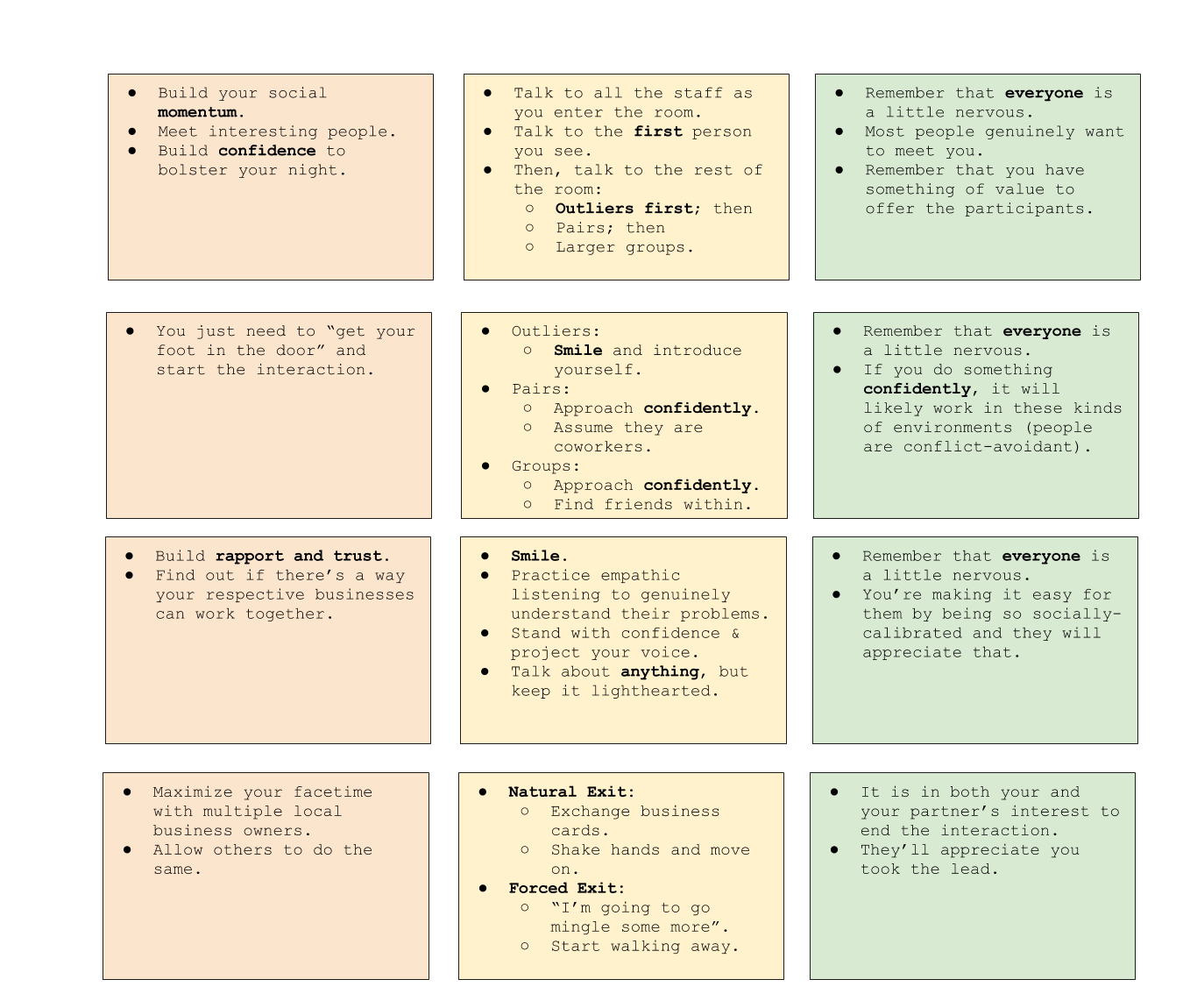
The second note here is that you want to act as if you were with your friends. This authenticity is absolutely crucial to building trust and it will take a ton of pressure off of you to say “the right thing”. On this note, however, don’t let this inhibit your focus on your networking goal.
Have fun, but don’t forget to talk to your top 5 and the meeting organizer!
The third idea I recommend here is to understand that everyone there is also nervous. Even the hardened veteran networkers get a little jittery before big events, so simply understand that and you’ll start to feel much more comfortable in the environment.
Use this to your advantage by going out of your way to introduce yourself to people nearby. You know they’re nervous, so they’ll be very gracious that you took the time to include them.
Finally, and probably most importantly, remember to smile. A smile can let you get away with so much, mostly because it helps to reinforce your friendly attitude to others (and more importantly to yourself). Smiling will help you to easily break into large groups and will help more reserved attendees open up to you (we’ll get into this a bit more in the “social dynamics section” coming up next).
Keep in mind, they key takeaway is this: enjoy yourself, but don’t lose sight of your goal.
Social Dynamics of Networking
Every networking event I’ve attended in the last year has fit into a standard “mold”. That being said, there are certain unspoken rules of networking.
The goal of this section is to outline them. We will :
- First discuss the different types of approaches you’ll be doing;
- Outline some more logistical information (where to be, what to say);
- Last, we’ll conclude with an analysis of the interactions themselves.
| The First Thing to Do
There’s an innate barrier to social fluidity inherent in all of us. The easiest way to break that is to “warm up” by talking to lot’s of people.
This is why I recommend talking to all of the staff involved with the event before it starts (security guards, receptionists, valet service, etc.).
Most importantly, I have a simple recommendation on what you should do as soon as you enter the room in which the event will be hosted:
Talk to the first person you see.
That’s it.
This helps you to build social momentum without allowing yourself to get in your head and think about who you should be talking to. Keep it brief (unless you hit it lucky and find a unique synergy between the two of you of course), and then move on.
Now, we’ll discuss the three types of approaches you’ll likely end up doing throughout the event.
| Approaching: Singling out Outliers (Easy).
One type of approach you’ll end up doing is what I like to call the “outlier” approach.
This happens when you walk up and talk to someone standing by themselves either on their phone or otherwise avoiding interaction with the larger group.
These people are usually just a little shy (perhaps it’s their first time there, or perhaps they didn’t have a networking strategy!), so they’re great for warming up.
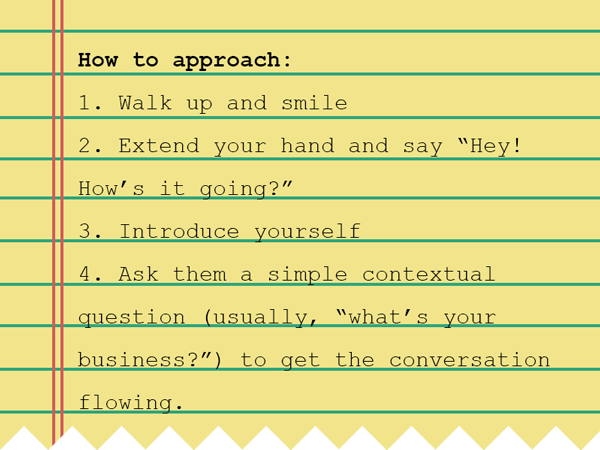
We’ll discuss what you should be saying (and how to exit the interaction) in a little bit.
| Approaching: A pair of people.
Approaching a pair is slightly more difficult than the outliers, usually because you have to interrupt their current conversation thread to do it smoothly.
It’s easy to do when you know how it works though:

This, done confidently, comes across as very natural. You’ll find quickly that (at least in Western cultures), people will more often than not default to welcoming you into the group if you make it known that you want to enter.
This is because there would be a ton of tension if they simply ignored you or rejected your request, and nobody wants to tarnish their image at these events. Just be friendly and don’t abuse this power.
| Approaching: Breaking into large groups (hard).
The group dynamic of “reputation saving” comes into play heavily when braking into larger groups. This is definitely the hardest to execute well, but here’s how you do it:
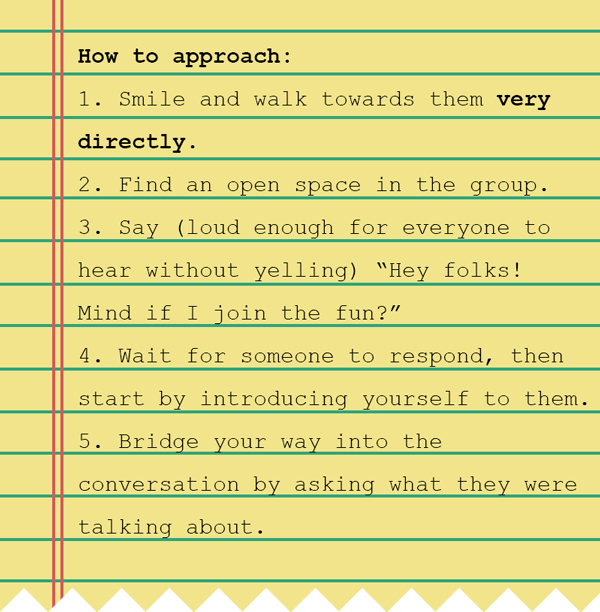
All in all, keep in mind that social dynamics are very fluid, so the only way to get better at this is to get out there and try it yourself.
Now that you know how to introduce yourself to the various social clusters you’ll find, we’re going to discuss where you should be doing all of this.
| Where to physically Stand (or Sit)
You obviously can’t interact with your “top 5” or anyone relevant to your business if you’re not physically in the correct location, so let’s figure this out.
It’s different for every event of course, but here are some best practices that I’ve extracted over the past few years:

Basically…
- If there’s a bar, be near the bar.
- People love doing business over drinks!
- Avoid presentations if you aren’t genuinely interested in them.
- It’s a waste of your precious time.
- Head to a nearby lounge or somewhere that you will likely find other attendees.
- In addition to your physical presence, invest in a passive networking aide (pictured below).
- This is a container or other mechanism that will hand out or collect business cards on your behalf.
- A “give us your business card” giveaway is a prime example of this done well.
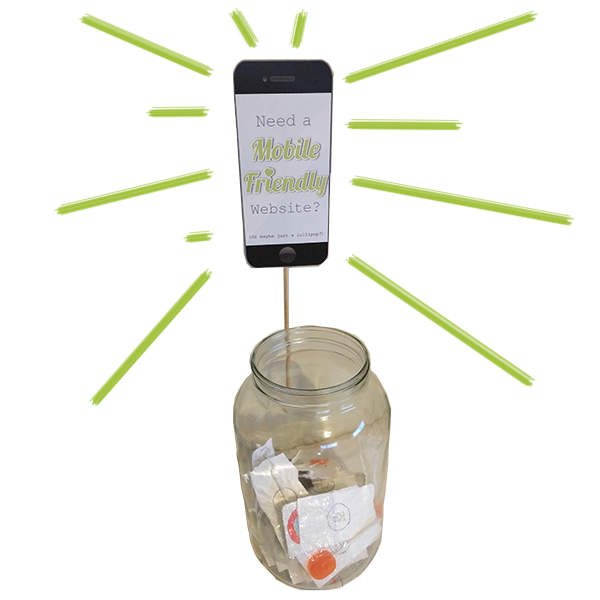
Always be thinking about your ideal customer and try to get in their head: where are they and how can you get there?
Now that you’re standing in the right place and know how you approach anyone, let’s further digest the dynamics of the interactions themselves.
The Interactions
Keep in mind here that the primary focus is to build trusting relationships that will at some point (today or in the near future) result in new business for you.
To accomplish this, you must remain problem & value focused, constantly asking questions and engaging your conversation partner. This section covers how to do that extensively by leveraging the following ideas:
- Emphatic Listening
- Non-Verbals
- Exiting the Interaction
| Emphatic Listening
This is my biggest frustration with networking events (and it’s all too common). It is incredibly obvious when someone isn’t listening to me and this pollutes the whole interaction.
Listening intently is probably one of the most valuable skills you can learn as an entrepreneur – we’re going to cover it here.
Essentially, you’re looking to express the idea that you’re actively listening and empathizing with the speaker’s underlying concerns and are not simply waiting for your chance to speak.
Here’s how you do it:
 1. Put yourself in their shoes.
1. Put yourself in their shoes.
Try to imagine the feelings your conversation partner was experiencing in the situation they are describing. Reflect that sentiment in your own facial expression.
2. Rephrase and reflect.
After your partner describes an anecdote, rephrase it in your own words and comment on how that likely made them feel.
For example, if someone tells you about their horrible commute, say something to the effect of:

I would say nothing showcases that you’re listening more than this. Get in the habit of going out of your way to do this.
Note: This is actually stolen from the legendary book How to Win Friends and Influence People by Dale Carnegie. Definitely check out that book if you want to expand on this topic further.
3. Movement mirror
Mirror the stance and movements of your partner. If they are closed off, fold your arms, if they are relaxed, lean against a wall.
This helps to build empathy between the two of you, as long as it’s not done in an obvious way (wait a few seconds before calibrating your posture).
| Non-Verbals
As we’ve already learned, humans are social creatures by nature.
Certain parts of our brains are focused almost exclusively on picking up nonverbal cues to help us understand social context.
For this reason, I confidently believe that non-verbals are more important than what you actually say.

When you’re just getting started you have essentially no reference experience, so here’s how you “fake it ‘til you make it”:
1. Stand confidently.
Prioritize this over movement-matching, because this has a psychological effect on you as well. Some quality stances include putting your hands on your hips,or simply pulling your shoulders back and pressing your chest outwards.
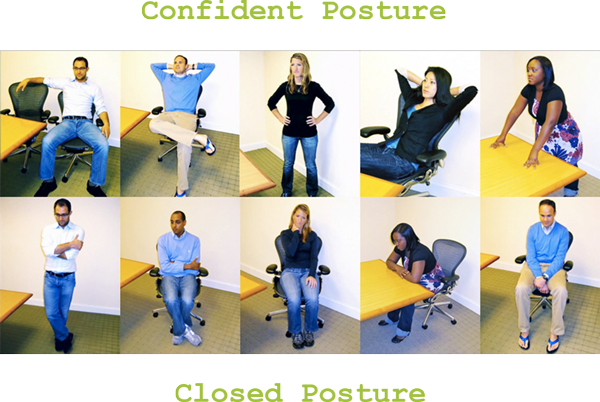
Most importantly, don’t put your hands in your pockets! If you’re holding a drink, do so at waist level, not chest-level.
2. Prolonged (calibrated) eye-contact.
You’ll quickly find that most people are deathly-afraid of looking you in the eye. If you’re able to do this right, you’ll give off an air of confidence that will do wonders for your plausibility later.
The only caveat here is to make sure to break eye contact once every 20 seconds or so for a brief moment to allow the tension to relax. Failing to do this will usually intimidate your conversation partner which is more or less harmful to building a productive relationship.
3. Get comfortable with silence.
If you don’t already know, silence is a natural part of any conversation. Most people are uncomfortable with it, but the secret is that it’s only uncomfortable if you think it will be. This is a concept known as state transference and is a very real part of social dynamics.
Use the silence to take a moment to think of something valuable to say about what your partner just finished saying, and don’t stress it.
So now that we know how to effectively interact with the other attendees in a manner that builds trust and empathy, we’ll focus briefly on what to actually talk about.
| Conversation Topics
You’re at this networking event for a reason (your networking goal), but it’s very important that you don’t sell that too hard.
I’m sure you’ve ran into the single-minded networker who’s pushing their company to no end and simply ignoring you.
Spoiler alert: that guy isn’t getting any business.
Here’s my 3-step strategy to keeping conversations effective:
- Smile, and talk about anything.
- Establish a genuine interest in the other person’s business (and subsequently their business problems).
- When asked, briefly mention your value proposition and move back to talking about the other person (unless you’re asked to elaborate, of course).
The conversation doesn’t have to always be about business (in fact, most of my clients ended up working with me after a conversation about their favorite TV shows).
Why? As you’ll find over time (at least in the consultant space), people buy from you because they like and trust you.
| Exiting the interaction
As much as we’d all like to talk to the same person all night and avoid approaching anyone else, that’s not really the most effective use of your time.
Yes, you should focus on depth rather than breadth when meeting new people, though you need to be aware and respectful of your partner’s time too.
At some point, you’ll have to exit the interaction. There are 2 reasons why this is the case (usually):
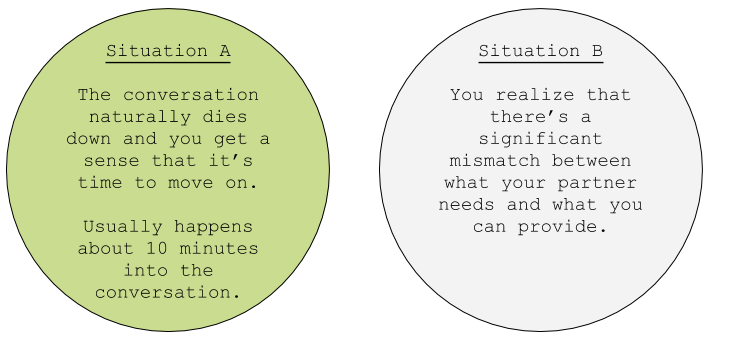
Note: This guide assumes the “mixer” event type, though it extends to any situation where there are many people in a room involved in various different conversation clusters.
Handling Situation A
This is what I call the natural exit. You both have enjoyed each others’ company for the past 10 or 15 minutes, but now you naturally want to go and talk to other people.
The simplest way to do this is to say:
“Well, [name], it was great meeting you! Do you have a business card I can take with me so we can stay in touch?”
Then, preface your follow-up (covered extensively in the next chapter), and tell them to enjoy the rest of their time at the event.
A typical interaction goes something like this:
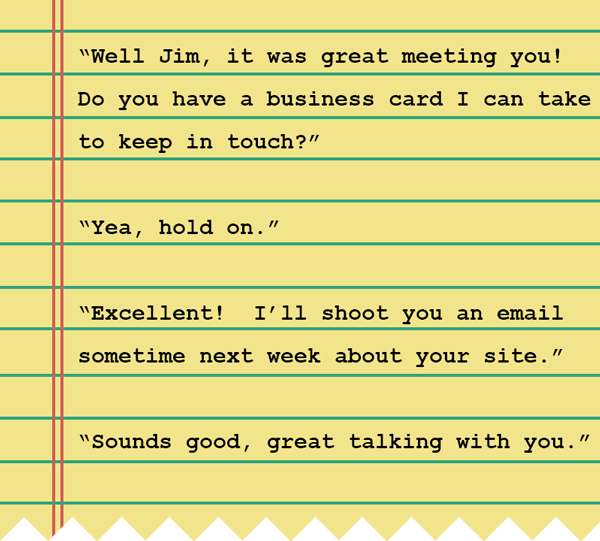
As you can see, this is very natural and organic way to close the conversation. It doesn’t always happen this way though: sometimes you’ll get some pushback or the conversation will naturally swing back into action for some reason.
Fortunately, you can handle this the same way I handle “Situation B”…
Handling Situation B
If you’re trapped in a conversation that’s clearly going nowhere (you’ll know what I mean), or you get pulled back into a conversation that you’re already trying to end naturally, there’s a really simple way to “force quit” the conversation.
Here’s my hard exit script:

…and immediately start to walk away.
This single line has saved me from hours of nervous chatter during precious networking time, and it’s (I think) the most polite way to tell your conversation partner: “stop talking to me, we both know that we need to move on”.
| A Quick Summary
I’m keeping this particular section light because you probably already know how to interact with people.
There are exceptions to every rule, and frankly the only way you’ll start doing this consistently well is if you network consistently for about a month.
Here’s a quick info-graphic describing the general cases I’ve outline above, but just always remember to default to being friendly and(most importantly) smile.

Networking Etiquette: “The Business Card”
Alright, now we’re going to tackle the ever present business card exchange.
Given that this is currently your primary means of staying in touch with your new contacts, it warrants its own section.
Here’s how it would work in an ideal world:
- You’d get their business card.
- You’d inspect it for 5-15 seconds.
- You’d carefully place it in your wallet/purse.
- You’d tell your partner when and why you’re going to follow up.
Let’s break this down to see why it’s so important…
First, you get their business card because only giving out your card gives away all your control.
The reality is that they probably won’t even remember you and subsequently won’t follow up with you. It’s your responsibility as a business owner to follow up with prospects and partners: not theirs.
But what if they don’t have a card? Write down their email address or phone number. My rule is this: if I don’t get their contact details before I leave, I’m essentially just abandoning the relationship entirely.
When you do get their card, take a look at it for 5-15 seconds. Flip it over, feel it, really ingest the magnificence of their card.
Why? As you’ll find in How To Win Friends and Influence People, making others feel important and becoming genuinely interested in them is incredibly influential. Most business owners spend way too much time on their business cards because they see them as an extension of themselves.
Take a few seconds to really digest the experience of the card – they’ll appreciate it. Don’t hold back any compliments either!
Yea, I know this sounds robotic, but frankly, everyone is doing this because it works, I’m just making sure you know so you don’t miss out.
Note: This is a great place to catch their name again if you’ve already forgot it.
Next up, carefully place it in your wallet or purse for the same reasons that we take a few seconds to digest the card. If you just stuff it in your pocket, it’s more or less an insult to the person you’re talking to.
This is even more important in Eastern cultures, though that’s a story for a different time.
Finally, you’ll want to preface your follow-up. This does 2 things:
- Justifies your follow-up later; and
- Distinguishes you from the crowd.
Your prospects will be much more likely to respond if you justify why you’ll be contacting them, and if you say that you’ll follow up a week or so from now (and you should, unless they need something urgently), you’ll appear in their inbox after the rush of novice networkers send out their canned follow-ups.
The art of following-up is incredibly-important, so we’ll devote an entire post to it up next, but it’s important that you understand that attending these events is 90% of the battle.
If all else fails, just go and talk to people, get their contact details, and follow up with them the following week. That’s it!
In the next section, we’ll detail what you do after the event to follow-up with your prospects.
Onward!